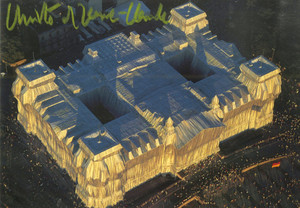
Christo, Wrapped Reichstag (Hand Signed Christo et Jeanne Claude) from the collection of Jeanne-Claude's personal assistant, 1995
Christo (Christo and Jeanne Claude)
Alpha 137 Gallery and Art Advisory
In business for nearly two decades, we are a well established, popular contemporary art boutique specializing in expertly chosen prints, multiples, and unique sculptures, design objects, works on paper and paintings by recognized artists, with a focus on the secondary market. We also have an impressive selection of scarce and coveted art historical ephemera, monographs and merchandise at different price points. Discover our small business: one of the best kept secrets in the art world, and join our ever-growing family of art lovers - from first time collectors to seasoned fine art professionals. Please note that works are available for purchase exclusively online, and we are not able to accommodate requests for in person viewings at this time.
For a short order art appraisal, please click the "Art Appraisal Services" option above. To reach us, click on the
Contact Us option above or at the bottom of this page.
An educated collector is our best client
ALPHA 137 GALLERY
ALPHA 137 GALLERY
CONTACT GALLERY FOR PRICE
Christo
Christo and Jeanne-Claude: Wrapped Reichstag, Berlin, 1971-1995, 1996
Hardback monograph with slipcase (hand signed and numbered - Hors Commerce edition, reserved for artists and contributors)
Signed by Christo, Jeanne-Claude and Wolfgang Volz and numbered numbered HC-694/HC-700 on the colophon
12 × 12 × 1 1/2 inches
Unframed
Makes a memorable gift! It's hand signed and numbered - with a piece of the actual Reichstag wrapping fabric laid in.
Signed by Christo, Jeanne-Claude and Wolfgang Volz and numbered numbered HC-694 on the colophon page
(an Hors Commerce [not for sale] edition reserved for artists and collaborators)
Original textured silver cloth with blue lettering on spine, housed in matching photo-illustrated slipcase, black lettering on spine. Contains an example of the original aluminum mesh used to wrap the Reichstag, framed in white cardboard (9 x 9") at inside back cover. Documentation of one of the startling and most stunning public art projects, representing the essence of conceptual art on a scale unmatched in the 20th century, one might say. 100 rock climbers abseiling down the facade of the Reichstag, without cranes or machinery being used in the project. This publication provides vivid documentation and a perspective of the extent of the project by the Bulgarian artist. His personal view, as expressed in The Guardian: "Artist - and above all architects - seek permanence," he said. "I don't. I like leaving nothing. That takes courage." His projects were funded mainly by selling preparatory drawings, always refusing sponsorship. Christo forbade the Three Tenors to perform a concert in front of the wrapped Reichstag. Fine condition, slipcase with minor wear.
Publisher: Taschen, Köln, 1996
Hardcover: 297 numbered pages with a massive collection of colored photographs finishing the book
Box :
12 by 12 by 1.5 inches
Slipcase:
11.5 by 11.5 inches
Book:
10.5 vertical by 11 inches
About the Wrapped Reichstag:
After a struggle spanning the seventies, eighties and nineties, the wrapping of the Reichstag was completed on June 24, 1995 by a work force of 90 professional climbers and 120 installation workers. The Reichstag remained wrapped for 14 days and all materials were recycled.
100,000 square meters (1,076,390 square feet) of thick woven polypropylene fabric with an aluminum surface and 15,6 kilometers (9.7 miles) of blue polypropylene rope, diameter 3.2 cm (1.26 inch), were used for the wrapping of the Reichstag. The façades, the towers and the roof were covered by 70 tailor-made fabric panels, twice as much fabric as the surface of the building.
The work of art was entirely financed by the artists, as have all their projects, through the sale of preparatory studies, drawings, collages, scale models as well as early works and original lithographs. The artists did not accept sponsorship of any kind.
The Wrapped Reichstag represents not only 24 years of efforts in the lives of the artists but also years of team work by its leading members Michael S. Cullen, Wolfgang and Sylvia Volz, and Roland Specker.
The Reichstag stands up in an open, strangely metaphysical area. The building has experienced its own continuous changes and perturbations: built in 1894, burned in 1933, almost destroyed in 1945, it was restored in the sixties, but the Reichstag always remained the symbol of Democracy.
Throughout the history of art, the use of fabric has been a fascination for artists. From the most ancient times to the present, fabric forming folds, pleats and draperies is a significant part of paintings, frescoes, reliefs and sculptures made of wood, stone and bronze. The use of fabric on the Reichstag followed the classical tradition. Fabric, like clothing or skin, is fragile, it translates the unique quality of impermanence.
For a period of two weeks, the richness of the silvery fabric, shaped by the blue ropes, created a sumptuous flow of vertical folds highlighting the features and proportions of the imposing structure, revealing the essence of the Reichstag.